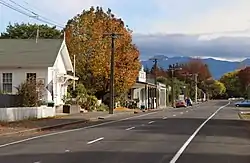Ongaonga, New Zealand
Ongaonga is a village in Central Hawkes Bay District of New Zealand's North Island. It is located 20 kilometres west of Waipawa and a similar distance from Waipukurau.[2]
Ongaonga | |
|---|---|
 Bridge Street in 2016 | |

| |
| Coordinates: 39.914°S 176.420°E | |
| Country | New Zealand |
| Region | Hawke's Bay |
| Territorial authority | Central Hawke's Bay District |
| Ward | Aramoana/Ruahine |
| Population (2018)[1] | |
| • Total | 168 |
.jpg.webp)
The village was founded in 1872 when Henry Hamilton Bridge subdivided his farm. The first house was built two years later, in 1874.[3] The general store and tearooms was opened in 1899 and still provides the local community and visitors with groceries, refreshments, postal services and petrol.[4]
The village is named after the Māori word for the native stinging nettle Urtica ferox.[5]
The modern village consists of a general store, tea rooms and the Sandford Arms Tavern. Ongaonga has a collection of historic buildings all built at a similar time by the Coles Brothers Builders and Joiners. The main street, Bridge Street, named after town founder Henry Hamilton Bridge, includes the historic Coles Brothers factory.[4]
The small country town also supports several sporting and cultural clubs. Ongaonga often joins with Tikokino in rugby, to compete against other Central Hawke's Bay clubs. Ongaonga also hosts an annual ANZAC day parade. The Ongaonga Golf Course is located one kilometre south-west of the town.[4]
Demographics
The population of Ongaonga was 168 in the 2018 census, an increase of 3 from 2013. There were 84 males and 87 females. 92.9% of people identified as European/Pākehā, 16.1% as Māori and 1.8% as Asian. 10.7% were under 15 years old, 10.7% were 15–29, 51.8% were 30–64, and 26.8% were 65 or older.[1]
| Year | Pop. | ±% p.a. |
|---|---|---|
| 2006 | 2,244 | — |
| 2013 | 2,295 | +0.32% |
| 2018 | 2,430 | +1.15% |
| Source: [6] | ||
The statistical area of Makaretu, which at 789 square kilometres is much larger than this village, had a population of 2,430 at the 2018 New Zealand census, an increase of 135 people (5.9%) since the 2013 census, and an increase of 186 people (8.3%) since the 2006 census. There were 867 households. There were 1,263 males and 1,170 females, giving a sex ratio of 1.08 males per female. The median age was 42.2 years (compared with 37.4 years nationally), with 528 people (21.7%) aged under 15 years, 357 (14.7%) aged 15 to 29, 1,170 (48.1%) aged 30 to 64, and 378 (15.6%) aged 65 or older.
Ethnicities were 83.1% European/Pākehā, 19.6% Māori, 2.6% Pacific peoples, 5.7% Asian, and 1.0% other ethnicities (totals add to more than 100% since people could identify with multiple ethnicities).
The proportion of people born overseas was 14.7%, compared with 27.1% nationally.
Although some people objected to giving their religion, 48.4% had no religion, 39.9% were Christian, 0.1% were Hindu, 0.1% were Muslim, 0.6% were Buddhist and 4.1% had other religions.
Of those at least 15 years old, 279 (14.7%) people had a bachelor or higher degree, and 408 (21.5%) people had no formal qualifications. The median income was $31,300, compared with $31,800 nationally. The employment status of those at least 15 was that 1,056 (55.5%) people were employed full-time, 315 (16.6%) were part-time, and 48 (2.5%) were unemployed.[6]
Education
Ongaonga School is a Year 1–8 co-educational state primary school.[7][8] It is a decile 6 school with a roll of 80 as of March 2020.[9][10]
Ongaonga Play Center and Ongaonga Town Hall are located next to the school.[7]
Over the last 50 years, youth organisations have come and gone. The town has hosted Scouts New Zealand and Girl Guides.[4]
References
- "Age and sex by ethnic group (grouped total response), for census usually resident population counts, 2006, 2013, and 2018 Censuses (urban rural areas)". Statistics New Zealand. Retrieved 1 February 2021.
- Hariss, Gavin. "Ongaonga, Hawke's Bay". topomap.co.nz. NZ Topo Map.
- Rangeview Memories of Ongaonga by Malcolm Ross, 2012 (book)
- Pollock, Kerryn (15 November 2012). "Ongaonga general store, 2009". Te Ara: The Encyclopedia of New Zealand. Wellington: Ministry for Culture and Heritage.
- Wassilieff, Maggy. "Stinging hairs of ongaonga". Te Ara: The Encyclopedia of New Zealand. Ministry for Culture and Heritage.
- "Statistical area 1 dataset for 2018 Census". Statistics New Zealand. March 2020. Makaretu (215600). 2018 Census place summary: Makaretu
- "Official School Website". ongaonga.school.nz.
- "Ministry of Education School Profile". educationcounts.govt.nz. Ministry of Education.
- "New Zealand Schools Directory". New Zealand Ministry of Education. Retrieved 26 April 2020.
- "Education Review Office Report". ero.govt.nz. Education Review Office.
| Wikimedia Commons has media related to Category:Ongaonga (town). |